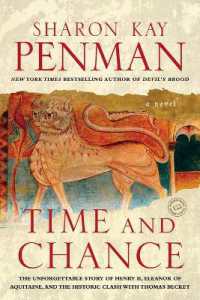Full Description
During the two centuries following European contact, the world of late prehistoric Mississippian chiefdoms collapsed and Native communities there fragmented, migrated, coalesced, and reorganized into new and often quite different societies. The editors of this volume, Robbie Ethridge and Sheri M. Shuck-Hall, argue that such a period and region of instability and regrouping constituted a "shatter zone." In this anthology, archaeologists, ethnohistorians, and anthropologists analyze the shatter zone created in the colonial South by examining the interactions of American Indians and European colonists. The forces that destabilized the region included especially the frenzied commercial traffic in Indian slaves conducted by both Europeans and Indians, which decimated several southern Native communities; the inherently fluid political and social organization of precontact Mississippian chiefdoms; and the widespread epidemics that spread across the South. Using examples from a range of Indian communities—Muskogee, Catawba, Iroquois, Alabama, Coushatta, Shawnee, Choctaw, Westo, and Natchez—the contributors assess the shatter zone region as a whole, and the varied ways in which Native peoples wrestled with an increasingly unstable world and worked to reestablish order.
Contents
1. Introduction: Mapping the Mississippian Shatter Zone
Robbie Ethridge 2. Events as Seen from the North: The Iroquois and Colonial Slavery
William A. Fox 3. From Refugees to Slave Traders: The Transformation of the Westo Indians
Maureen Meyers 4. "Caryinge awaye their Corne and Children": The Effects of Westo Slave Raids on the Indians of the Lower South
Eric E. Bowne 5. Catawba Coalescence and the Shattering of the Carolina Piedmont, 1540--1675
Robin A. Beck Jr. 6. "Indians Refusing to Carry Burdens": Understanding the Success of Catawba Political, Military, and Settlement Strategies in Colonial Carolina
Mary Elizabeth Fitts and Charles L. Heath 7. "The Greatest Travelers in America": Shawnee Survival in the Shatter Zone
Stephen Warren and Randolph Noe 8. Tracing the Origins of the Early Creeks, 1050--1700 CE
Ned J. Jenkins 9. Alabama and Coushatta Diaspora and Coalescence in the Mississippian Shatter Zone
Sheri M. Shuck-Hall 10. Violence in a Shattered World
Mathew H. Jennings 11. Razing Florida: The Indian Slave Trade and the Devastation of Spanish Florida, 1659--1715
John E. Worth 12. Shattered and Infected: Epidemics and the Origins of the Yamasee War, 1696--1715
Paul Kelton 13. Choctaws at the Border of the "Shatter Zone": Spheres of Exchange and Spheres of Social Value
Patricia Galloway 14. Shatter Zone Shock Waves along the Lower Mississippi
Marvin D. Jeter 15. Picking up the Pieces: Natchez Coalescence in the Shatter Zone
George Edward Milne Afterword: Some Thoughts on Further Work
Robbie EthridgeBibliography List of Contributors Index








